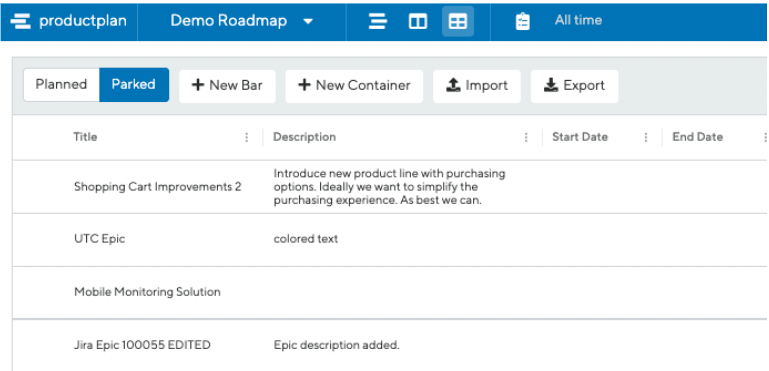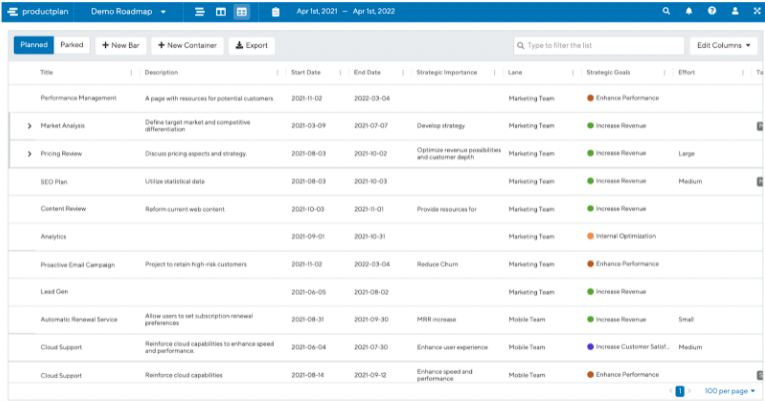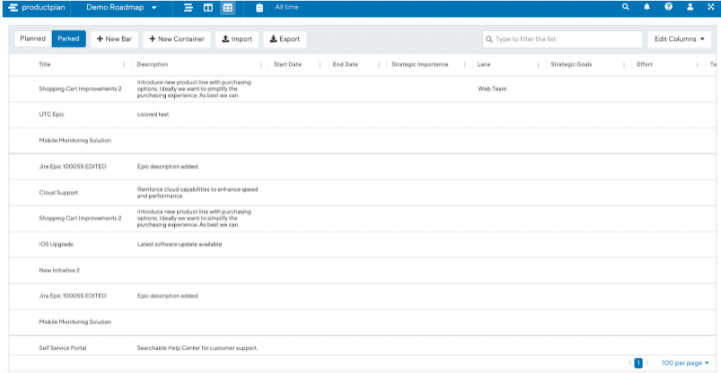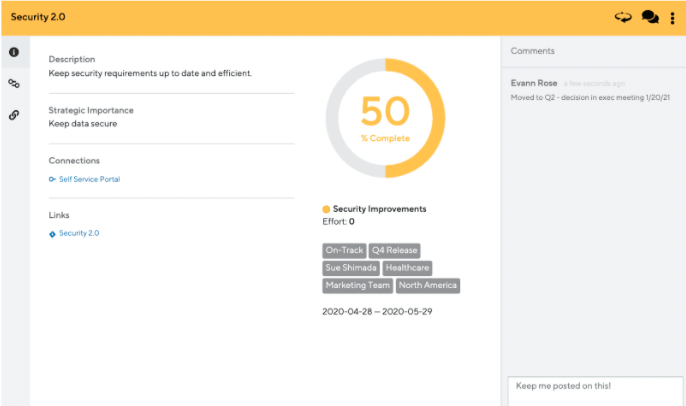A common reason product teams have trouble staying organized is that the information they need to maintain becomes scattered across many sources. And if these teams have inconsistent methods of communicating with stakeholders, staying organized and on track can be even more difficult.
This post will walk you through a few examples of how ProductPlan’s roadmapping app can help you solve both of these challenges.
1. Keep Planned and Backlog Initiatives Separate But Centrally Located

One challenge we’ve heard hundreds of times from product teams is the frustration of moving back and forth between the roadmap and the backlog. Many teams keep their product roadmap in one place and the backlog in another, usually a spreadsheet.
Bouncing between these views is tedious and time-consuming in and of itself. But the real challenge is that the backlog spreadsheet is often just a dumping ground for ideas. Rarely do product teams organize their spreadsheet lists by adding business intelligence—such as potential benefits and costs—for each backlog item.
Solution: ProductPlan’s Parked Section
ProductPlan makes it easy for your product team to keep all your backlog ideas in a standalone area of the app. No more app hopping to review backlog items in a spreadsheet.
For epics, themes, and other initiatives your team is ready to place on the roadmap, you can use the Planned View, which looks like this.

These in-flight items will be what your team sees displayed on your roadmap view, organized as color-coded bars and containers. For the future opportunities you want to capture but which aren’t ready for the roadmap, your team can use the Parked View, which looks like this:

Also, unlike the typical backlog list contained on a spreadsheet, ProductPlan’s app makes it easy for your team to evaluate each backlog item, weigh it against the others in terms of costs and benefits, and assign it an overall prioritization score. When you return to your backlog looking for new initiatives to add to the roadmap, you can review these valuable strategic details.
Now your team has all initiatives—the ones currently in progress and ideas for future projects—stored in one place: your ProductPlan app.
2. Sync Your Developers’ Task-Level Updates with the Product’s Overall Progress

Another challenge product teams face staying organized is tracking and sharing the progress on their product development.
Dev teams usually update their progress with project management apps like Jira, Asana, or Trello. When they complete a task on their to-do list—a user story, for example—the developers will mark it complete in their Jira environment. But the roadmap view will remain unchanged.
In reality, one of the bars on the roadmap is now a little closer to complete, thanks to the dev team’s work on that story. But no one will know that by looking at the roadmap. To keep up with those day-to-day details, the product team will need to review the developers’ tasks in Jira frequently.
What happens when an executive asks the product team for a quick update on how things are going? The product manager will have to scramble, review the developers’ Jira progress, and prepare an impromptu status update.
Solution: ProductPlan’s Integrations and “Percent Complete” Feature
ProductPlan integrates with many popular project management apps: Jira, Trello, Asana, Azure DevOps, Confluence, GitHub, etc.
When integrating any of these apps into your ProductPlan environment, your team can also add a Percent Complete option. This will allow you to associate tasks in the project app with a specific epic or initiative in ProductPlan.
Let’s say you have an epic depicted as a bar on your ProductPlan roadmap. That epic is comprised of three stories in your development team’s Jira environment. You can assign points to each story, which will reflect its contribution to the overall progress of the epic.
Now let’s assume each of these three stories represents an equal percentage of the total points. When a developer marks one story complete in Jira, that will automatically mark your epic as 33% complete. And when you click into the bar in your roadmap view, ProductPlan will display a “33% complete” pie chart.
Now your team can track the interim progress of every item on your roadmap—and display that progress visually in real-time.
3. Automate Notifications to Your Stakeholders About Roadmap Updates

Yet another common challenge for product teams trying to stay organized and aligned with stakeholders is the need to continually send out updates when something on the roadmap changes.
If your team uses a roadmap app like ProductPlan, you’ll have a single source of roadmap truth for your company. That means you’re already halfway there in terms of maintaining stakeholder alignment.
You can send all relevant stakeholders a link to your ProductPlan roadmap online. That will ensure your coworkers can always find the current view of your roadmap—not an outdated version in a spreadsheet or presentation file.
But in terms of keeping your team up to date with your latest strategic plan, what about the other half of the equation? If you make an update to the roadmap, the only way to be sure your cross-functional team knows about it is if you send out a communication. Otherwise, you’ll just have to hope they all check-in and view the roadmap regularly.
Solution: ProductPlan’s Automated Notifications Through Slack and MS Teams
When you integrate your Slack or Teams apps with ProductPlan, you can set rules for automatically sending various types of roadmap notifications to the team channels you select.
For example, suppose you move the timeframe of an epic on the roadmap. In that case, you can instruct ProductPlan to automatically send out a notification to everyone in whichever Slack channels you want.
Or, if someone drops a comment into your ProductPlan roadmap, you can have the app send you or your whole team an update through Slack. That way, you won’t need to continually monitor your roadmap for team comments or questions.
And remember we discussed adding a Percent Complete tracker to your initiatives? You can also instruct ProductPlan to notify stakeholders through Slack or Team anytime someone marks a task as completed in their project tracking app, moving a bar on your roadmap toward completion. Your stakeholders can receive Slack messages such as, “XYZ Epic is 67% complete.” Cool, right?
These are just a few ways product teams stay organized and aligned with their organizations using ProductPlan. To discover more ways for your team, try our roadmapping app for free.


